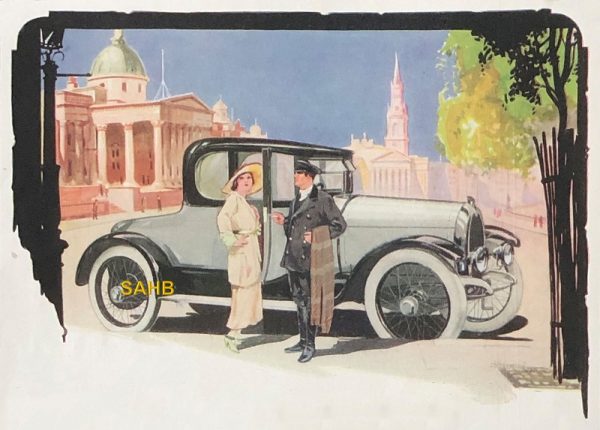
An advertisement for a modest car can always be enhanced by the addition of stylish people such as the elegant lady and her chauffeur in this example from April 1920.
The car in question is a Storey, with its distinctive oval radiator. The body is a London Coupé, a 2-seater with ‘Double Dickey Seat’, on a standard 14.3HP chassis. The strapline following the model name was “The Car of Refinement and Elegance.” It was not the only body on this chassis: a similar advertisement in 1919 featured a sporty open tourer speeding along the road, driven by a young lady, her hat at a rakish angle, with well-dressed golfers in the background. And in that advertisement Storey were able to quote a testimonial from no less an owner than the distinguished actress, theatre manager and producer Gladys (from 1967 Dame Gladys) Cooper.
The Storey family had been in the engineering industry since the 19th Century. The company was founded by mining engineer John Henry Storey as John H Storey & Co, engineers and toolmakers, at Hatcham in southeast London. His son William joined the company in the early years of the 20th century and in 1916 the firm’s name was changed to the Storey Machine Tool Co. Ltd., based in New Cross, London SE14. William was a car enthusiast, and before World War I experimented with prototypes equipped with engines from Coventry Simplex and Wisconsin – and even a radial engine.
War work was focused upon building aero engines, but with peacetime the company found itself with nothing to make and decided to produce cars on a large scale. A new factory was built in Tonbridge in Kent, but the early advertising suggests that the initial cars were built at the New Cross works until the new factory was ready.
There were two models: a 2296cc 14.3HP and a 2995cc 20HP, both powered by 4-cylinder Chapuis-Dornier engines. Even when production was moved to the new Tonbridge factory, bodies were still made at New Cross in the engineering works. By 1920 Storey’s own 1496cc engine was ready, but the company was already facing bankruptcy. William claimed to have built 1000 cars in the short 12-month life of the company, but this high figure is doubtful.
William’s brother Jack entered the fray in 1921 and from small premises in Clapham Park built a few cars from existing components and with engines from wherever he could find them – including reportedly at least one 6-cylinder from Buick. The make finally disappeared in 1930 and the business became a garage. William Storey returned to machine tool manufacture; he died in 1971.
Image courtesy of The Richard Roberts Archive: www.richardrobertsarchive.org.uk







Leave a Comment